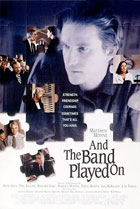
Director:Roger Spottiswoode
Duration:141 minutes
Year:1993
Key words:Pandemic/epidemic, public health and societal response
Summary:Exploration of the impact of, and reaction to, the HIV/AIDS epidemic presented largely from the perspective of the Centers for Disease Control (USA).
Degree of public health theme coverage:This is a drama based fairly closely on historical events concerning the emergence and public health response to the HIV/AIDS pandemic. The whole movie deals with a wide range of public health issues via the emerging information and response to a new pandemic. There are also links made with an Ebola Fever outbreak in the Congo.Score=5/5
Sophistication of analysis of public health content:The movie shows the complexity of the issues very well ie, the lack of the response at the central government level, the public health sector response (Centers for Disease Control; Food and Drug Administration (FDA) – responsible for regulating blood banks); the response of concerned public health people within the CDC and San Francisco; the response of private organisations (blood banks); the response of laboratory scientists; the response of the gay community and its leaders; the response of private sector (bath house owners); doctors not revealing true cause of death; and aspects of the wider societal response (eg, police, a preacher, embalmers etc). The issues particularly relate to the gay community but there is some mention of other marginalised populations eg, Haitian refugees and injecting drug users. The importance of the connotations of a disease's name is dealt with ie, the name is changed from GRID (which included the term “gay-related”) to “AIDS” to remove the stigma of disease. Score=5/5
Potential for empowerment and use of advocacy:This movie seems very empowering as it shows how good epidemiology can provide information (eg, that this disease was sexually transmitted), how critical having the people arguing for financial resources need for research is, how public health people can work with communities to get things done, how the gay community advocated for more research funding etc. There is some focus on Don Francis the epidemiologist who is also an advocate for an improved response and taking a more precautionary approach eg, closing bath houses and warning people that this is a sexually transmitted disease. But also the CDC people are shown working cooperatively in a team effort.Score=5/5
Persuasiveness of the movie:The movie is very persuasive given that it is based on real historical events. The depth of analysis is good. There is also effective portrayal of the emotional issues – around grieving, around the gay community reacting to loss of freedom, around the threat of the unknown, etc. The statements and actions reflecting homophobia and fear of various people/groups is shown eg, “gay plague”. It might seem that the strong ego of one of the laboratory scientists is somewhat unrealistic.Score=5/5
Engagement & cinematic quality:The movie is engaging with very good acting (including some well known movie stars). The pace is good and the crowd scenes looked like (and maybe were) genuine footage.Score=5/5
Total score = 25/25
Questions for discussion:
- What were the lessons for how a society responds to a new emerging threat?
- If a new disease arose again, do you think society would have similar responses?
Other information:
- There is a Wikipedia article on this movie - found here
- A book of the same name was written by Randy Shilts and the entry in Wikipedia is very detailed - found here
- Back to Films in Undergraduate Public Health Teaching home page
CONTACT US
Associate Professor Nick Wilson
Department of Public Health
University of Otago, Wellington
PO Box 7343
Wellington South 6242
New Zealand
Tel: +64 4 385 5541 ext 6469
Fax: +64 4 389 5319
Email: nick.wilson@otago.ac.nz